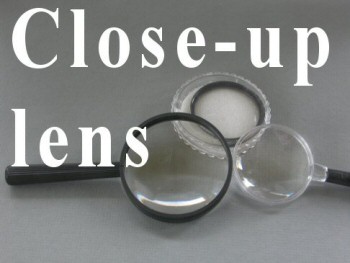
The Close-up Lens
or sometimes it is called a Close-up Filter except that a filter adjusts the quality of the light, whereas a lens focuses light...................... But they do look similar.
<< -- One photographic 2 dioptre CU lens in it's box and two magnifying glasses. The black one is 5 dioptres and the clear one is 10 dioptres.
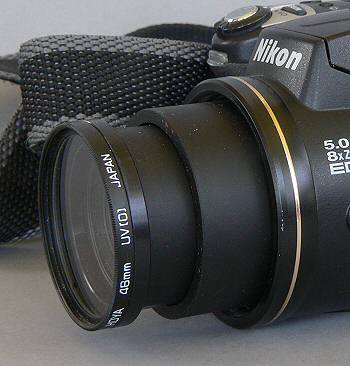
An adaption for the Nikon 5700 with a 43.5mm<46mm step-up ring turned to fit the 43mm front of the lens. When camera is turned off it sits nicely just proud of the body.
CU lens are to be found in many forms from the high quality and expensive double element and coated for best photographic results down to the plastic magnifying glass you buy at a discount store for 50 cents. They all do the same job and the cheap things can be an interesting introduction to their use.
Their purpose is to modify the focus of another lens, such as your eye's or a camera's lens.
They come with different identification such as Canon's 500D or 250D, Nikon's '0' and '1' but to get a grip on them it is easiest to describe them the way an Optometrist does by their power in dioptres.
A one dioptre has a focal length of 1000mm and a quarter dioptre, as you might find in a pair of glasses, has a focal length of 4 metres.
While a 4 dioptre has a focal length of 250mm.
The focal length of a lens is the distance it takes to bend the light from infinity to a point. Try a magnifying glass and focus the sun to a point. The distance between glass and point is it's focal length.
1000/dioptre power = focal length.
1000/focal length = dioptre
Say your camera lens is set at infinity then a 2 dioptre will focus the camera at 500mm or 20 inches approximately.
When you focus the camera to 500mm, the best the older SLRs could do, it is in effect a 2 dioptre lens. Adding the 2d CU lens gives the focusing power of 4 dioptre or 250mm.
With a digital camera itself capable of focusing [using automatic focusing or manual] down to 5cm [20 dioptre] when we add the 2d we have a total of 22d or 45mm.
Even if we add a powerful 10d it only makes 30d or 33mm ..... so CU lens on their own are not the way to take big close-ups or 'macro' as many call them these days.
The best use of CU lens
Is when we combine the magnifying power of the CU with the narrow angle of view of a telephoto. longer focal length lens, or zoom.
While the adverts boast that their camera can focus down to 10cm, 5cm, and even one cm, they do not usually tell you this is only at wide-angle .... when for all the closeness they still take in a wide view of the subject.
But adding even a moderate two dioptre lens permits a x12 zoomed pro-sumer to take a 3cm across subject. That is when at full zoom it can only focus to 2 metres .. no names no pack drill.
Adding a CU lens does restrict one to working no further away from the subject than the focal length of the dioptre.
So on the unmentioned camera with a 2d we have a working range of between 20 inches and 14 inches and achieve the 3cm across subject.
Using a 4d [or a pair of 2d's] we can get a 2cm across subject area.
So for the DSLR user it is better to get a 200mm macro lens than shorter. Most give the same result of 1:1 magnification where the size of the image on the sensor is the same as in real life.
Other advantages of using a dioptre with a longer focal length is that the dioptre keeps you away from the subject permitting light to get at it, a live subject is less likely to be scared, and if it is venomous you are less likely to get bitten
You may well know that a wide-angle lens because of it's short focal length has more depth of field than a longer lens. But more important in using a CU lens is that for a given image size the depth of field is pretty much the same whatever focal length is used.
Depth of field .... a lens is only really sharp at the point it is focused on, but our eye's tolerance permit us to accept as sharp objects closer and further away from the point of focus. See 'Circle of Confusion'
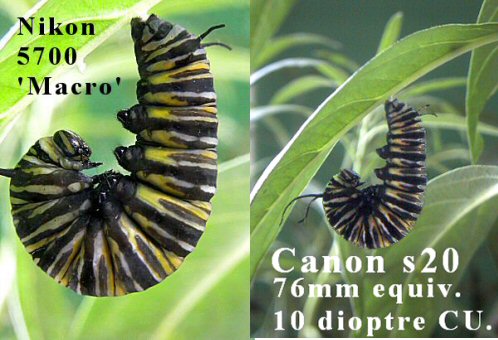
A comparison of what is possible with the 5700 and a Point and Shoot with a 10 dioptre. Illustrating how even an x4 zoom gets a closer view. The 5700's 'macro' mode only works in mid zoom.
Below is a comparison using various focal length lens from my stable of 35mm to large format cameras. Using the Nikon 5700 in both macro and normal mode but at full zoom. 'Lts' means Lens to Subject Distance. 'LF' is a 135mm lens from my 5x4 camera.
Right -- shows that unless the camera has a narrow enough angle of view to see through the CU lens you get vignetting
Below -- Using a couple of 2 dioptre lens and the full frame result. Panasonic FZ20 using full x12 zoom.
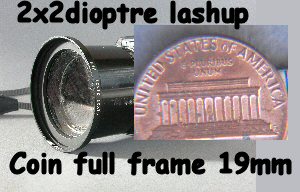
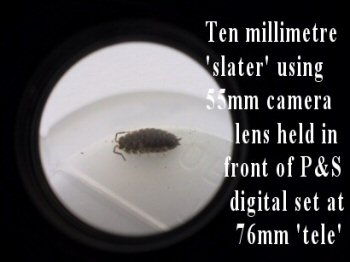
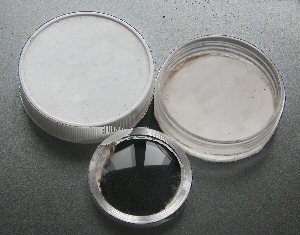
Since I have a lathe I made this lens holder for a plastic lens from a pair of spectacles. The box is the thread of a plastic jar cut from the jar and some plastic sheet stuck to it. Since plastic scratches easily the lens is protected with tissue in the box. It is a 3.25 dioptre.
The more powerful a lens the more likely will you get soft focus at the edges of your shots, but a lot of the time this doesn't matter or can be cropped in editing. An expensive lens will not suffer from this I'm told, I've never spent that sort of money.
Below is a grub using a 2 dioptre on the 5700 with full zoom from a distance of about 9 inches.
It is easy to get larger than life shots with a long lens and a CU lens.
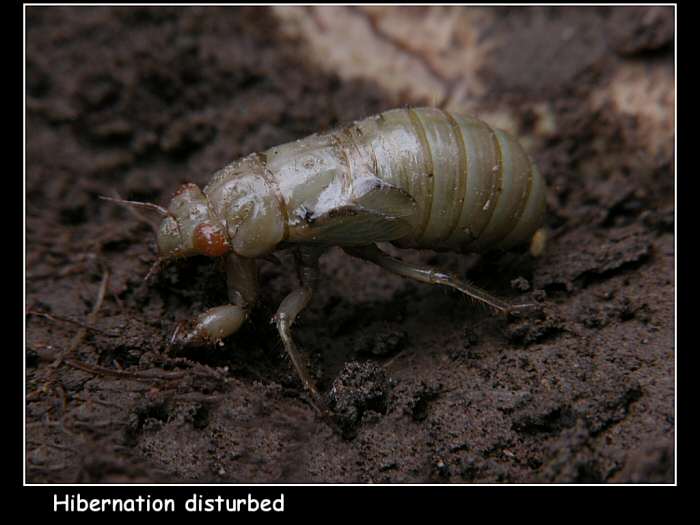

Have fun with your close-ups, or macros if you like :-)